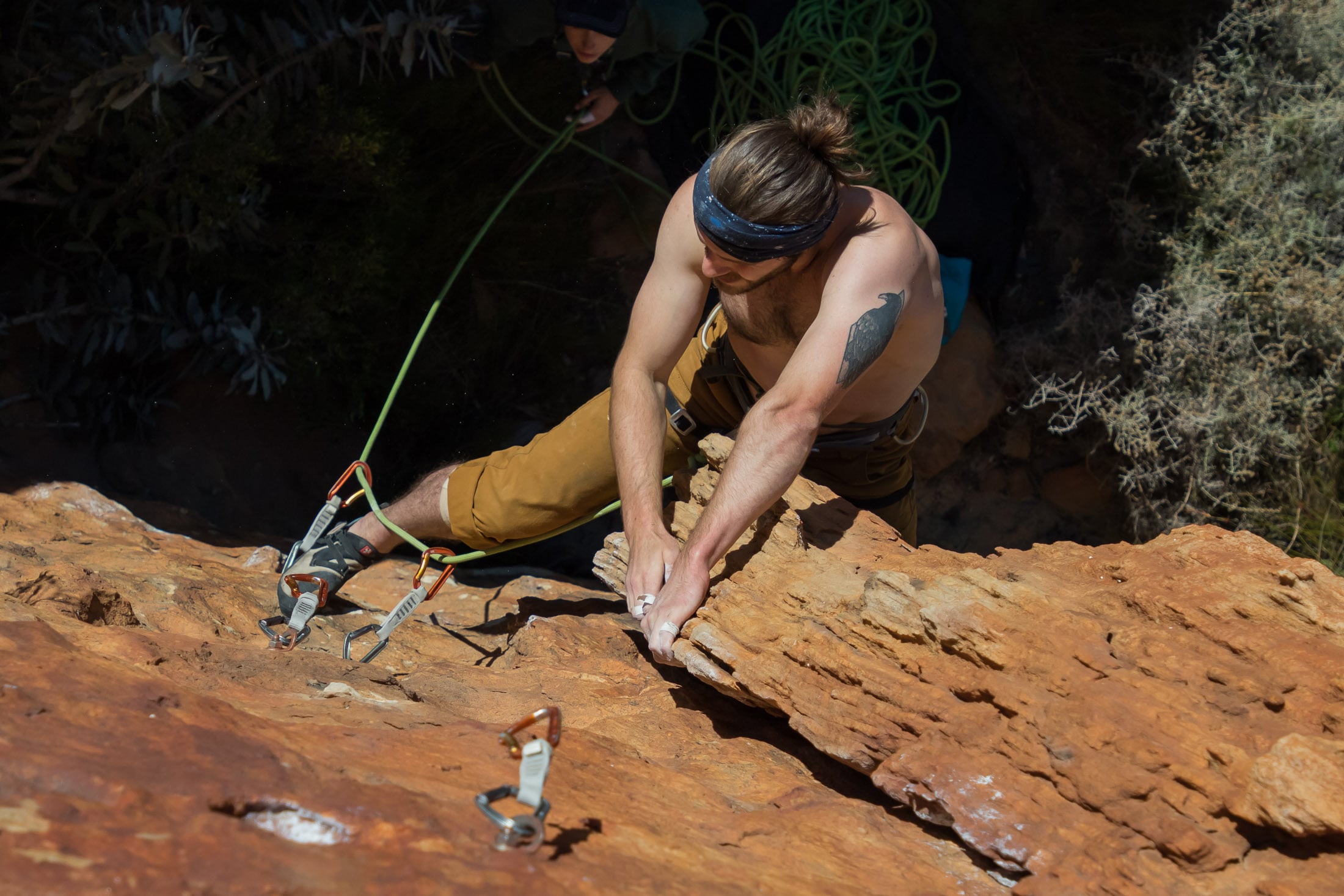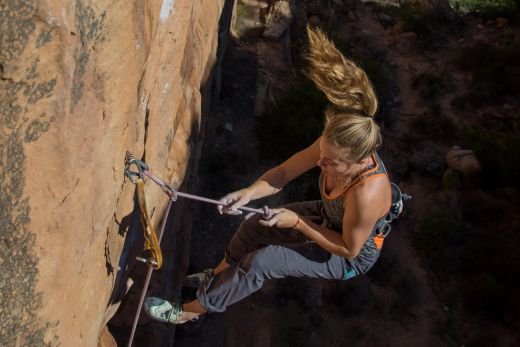Maybe you haven’t heard of ‘fall factor’ but don't know what it is, or you actually know what this term means but you don’t know why it’s important to avoid a high fall factor. Either way, this article will give you everything you need to know about this measure of fall severity. In the next several paragraphs, I will explain how fall factor is calculated, how it contributes to impact force, and how to avoid high-impact falls.
- What is fall factor?
- Factors that contribute to impact force
- What is a dangerously high impact force?
- How to avoid dangerous falls
What is fall factor?
Fall factor is simply the distance that a climber falls divided by the length of rope available to absorb that energy in that fall. According to this principle, a low fall factor results in a lower impact force while a high fall factor results in a higher impact force. Practically, what this means is that a short fall low on a route can actually involve a higher impact force than a longer fall from a point high on that route.
Even a fall with a relatively low fall factor of 0.7 can involve a high impact force if certain components in the system don’t absorb some of the energy. And falls with a fall factor greater than 1 will almost always be harsh or even dangerous. A factor 2 fall is the most dangerous or high-impact fall that a team can experience and should be avoided at all costs (more about this a little later).
Factors that contribute to impact force
Fall factor is only one of several things that contribute to the impact force of a fall. Belayer displacement, the amount of slack, the rope’s ability to absorb energy, and the effects of friction all play a part in reducing or adding to the forces that act on the climber and protection during a fall. Knowing how these factors interact is key to avoiding harsh or dangerous falls.
Slack
If the belayer puts out extra rope, the length of the fall and the length of rope in play increase equally. This can have a positive or negative effect on the impact force depending on what the fall factor would be without slack. In the case of falls that have a fall factor less than 1, more slack can increase the fall factor and impact force. But in the case of falls that have a fall factor more than 1, extra slack can reduce the impact force. But now there’s a caveat: It’s much easier to give a soft catch when there is some slack in the system. This more than negates the impact-increasing effect of the extra slack, meaning that it’s better to give the climber some slack if you intend to soften the catch. Hard is Easy has an excellent video that explains this in greater detail.
Rope elongation
Climbing ropes are dynamic for one very important reason. When they stretch, they absorb some of the energy in a fall. However, when a rope is loaded harshly, as it can be in a big fall, it temporarily loses some of its stretchiness and energy-absorbing capacity. If the rope is then subjected to another big fall before it has had a chance to ‘recover’, the impact force of that fall will be even higher than the first. This impact-increasing effect will be repeated with every subsequent fall until the rope is absorbing very little energy (and the climber and gear are being subjected to dangerously high impact forces). To avoid this, let your rope ‘rest’ for 10 minutes before taking another whipper on it. Alternatively, you can tie into the other end.
Friction between rope, hardware and rock
On routes that take a relatively direct line, the rope can move relatively smoothly through the carabiners on quickdraws and protection. But on routes that zig-zig, the acute angles between rope and hardware create friction, which reduces the amount of rope available to absorb energy in a fall. But it’s not only gear that can create friction and trap the rope. Rock features can also create a huge amount of friction where the rope has to bend sharper around it, as it might at roofs and corners. If you have to climb around such a feature high on a route, know that it can significantly shorten the length of rope that will absorb the energy in a fall.
Belayer displacement
The most significant thing a belayer can do to reduce the impact force of a fall is allow themselves to be lifted by the weight of the climber – or even give a small jump to overcome inertia. By lengthening the fall this way, a belayer can slow the falling climber more gradually, reduce the impact force on all components in the system, and slow the speed at which the climber swings into the wall (another equally important type of impact). However, there are limitations to this tactic. If you are going to lengthen a climber’s fall, there has to be space for him to fall into. This means that the climber needs to be high enough on the route (at the very least above the third bolt) and have no ledges below him – unless these can be avoided.

The other limitation of this tactic involves multi-pitch climbing, where the belayer’s movements are restricted by their connection to the anchor. If the rope (or PAS) between the belayer and anchor is short, a big fall can pull the belayer into the wall (possibly causing injury) and limit their ability to absorb some of the energy in the fall. To avoid this scenario, a belayer should lengthen their connection to the anchor if possible.
What is a dangerously high impact force?
The most force you are likely to generate in a leader fall is 7kN or 8kN. That would be a factor 2 fall straight onto the belay. Sounds horrific. But harnesses are rated to 15kN, and ropes can withstand 14kN to 18kN even when stretched. So why should you be worried about falls with a high fall factor when they won’t create forces anything close to these figures? Well, there are three reasons.
A belay anchor can fail in a factor 2 fall
Your belay anchor is your last line of defence, and you want to protect it at all costs. This is why it’s so important to avoid a factor 2 fall – it puts the full force of the fall straight onto the anchor. If the anchor is bolted, it would probably survive this. But an anchor built from trad gear can fail at such high forces. This is especially likely if you’re forced to build an anchor from smaller gear or place protection in poor quality rock. Many climbers simply overestimate the strength of their anchors thinking that an anchor’s strength is equal to the sum of its components.
Trad protection can fail at impact forces lower than 7kN
Most trad gear smaller than a .3 Camalot or #6 Stopper is rated lower than 7kN, meaning that such gear can fail in falls less severe than fall factor 2 even if they are placed perfectly and in solid rock. And if the same gear isn’t placed properly or in good rock, it can fail at impact forces much lower – as low as 3kN, a force that could easily be generated in a lead fall. The bottom line is that it is essential to limit the fall factor and impact force of a fall when relying on marginal or smaller pieces of protection.
You can still be injured even if gear doesn’t fail
Even if gear doesn’t fail as a result of a high impact force, it can result in injury. Besides the risk associated with swinging into the wall hard – as usually happens with a harsh fall – there is also the danger of whiplash or spinal injury that can result when a falling climber is stopped suddenly. Accident reports show that even falls less severe than factor 2 (and with impact forces of 6kN) can cause injury.
How to avoid dangerous falls
There are at least least three things you can do to mitigate the risk of of a high impact fall.
Place your first piece of protection early
On traditionally protected pitches, you want to place the first piece of gear as soon as possible to avoid a factor 2 fall. Sport pitches should be bolted with this in mind, but always be aware of the danger – until you clip the first quickdraw or piece of protection, a high impact fall is a real danger. To avoid a fall straight onto the belay, it can be a good idea to clip the first draw to one of the two bolts when leaving the stance (only do this with bolted stances or bomber trad gear).
Let your rope recover after a harsh fall
A rope needs to ‘rest’ for several minutes after a fall to regain its elasticity. If you take another fall on your rope before it has fully recovered, it will absorb even less energy, making the fall even harsher. This amplification of impact force will continue for every fall that occurs before the rope has had a chance to regain some of its elasticity. It’s also important to note that a rope will permanently lose some of its elasticity if subjected to many falls (hundreds), and a lack of stretchiness could indicate that it’s time to retire your rope.
Know how and when to give a soft catch
A soft catch reduces the impact force on gear and ensures that the climber comes back into the wall more gently. To soften a catch, a belayer gives a little jump just as the rope – with a plummeting climber on the other end – goes tight. Having already imparted some energy to overcome gravity and inertia, the belayer is lifted off the ground as the energy in the fall is dissipated. If at a multi-pitch stance, the length of the belayer’s connection to the anchor will determine how much they can be lifted in a big fall.
Learn more
You now have everything you need to know about fall factor. But don’t stop here. On this website you’ll find many more in-depth how-to guides on everything from anchor building to rappelling as well as many more gear guides. You can find these under the different sections in the categories menu, or, better yet, sign up for my newsletter to get all the latest from Trail & Crag delivered straight to your inbox.
